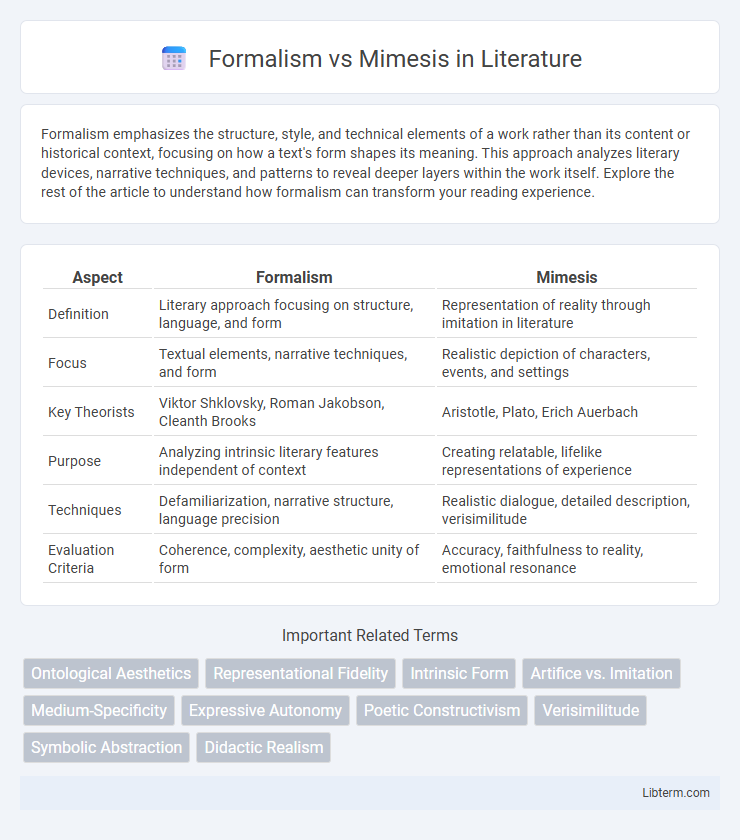Formalism emphasizes the structure, style, and technical elements of a work rather than its content or historical context, focusing on how a text's form shapes its meaning. This approach analyzes literary devices, narrative techniques, and patterns to reveal deeper layers within the work itself. Explore the rest of the article to understand how formalism can transform your reading experience.
Table of Comparison
| Aspect | Formalism | Mimesis |
|---|---|---|
| Definition | Literary approach focusing on structure, language, and form | Representation of reality through imitation in literature |
| Focus | Textual elements, narrative techniques, and form | Realistic depiction of characters, events, and settings |
| Key Theorists | Viktor Shklovsky, Roman Jakobson, Cleanth Brooks | Aristotle, Plato, Erich Auerbach |
| Purpose | Analyzing intrinsic literary features independent of context | Creating relatable, lifelike representations of experience |
| Techniques | Defamiliarization, narrative structure, language precision | Realistic dialogue, detailed description, verisimilitude |
| Evaluation Criteria | Coherence, complexity, aesthetic unity of form | Accuracy, faithfulness to reality, emotional resonance |
Understanding Formalism: Core Principles
Formalism centers on the intrinsic features of a text, emphasizing structure, style, and language over external context or content. It advocates the analysis of literary devices such as symbolism, meter, and narrative techniques to reveal deeper meaning embedded within the work itself. This approach prioritizes the form and aesthetic arrangement as the primary source of meaning, contrasting with mimesis, which focuses on imitation of reality.
Defining Mimesis: Imitation in Art
Mimesis in art refers to the imitation or representation of reality, emphasizing accurate depiction of the external world. This concept, rooted in classical philosophy, particularly Aristotle's Poetics, highlights how art mirrors life by reproducing natural forms, actions, and emotions. The effectiveness of mimesis relies on the artist's ability to create a lifelike portrayal that resonates with the audience's perception of reality.
Historical Origins of Formalism and Mimesis
Formalism originated in early 20th-century Russian literary theory, emphasizing structure, language, and literary techniques over content or historical context. Mimesis traces back to ancient Greek philosophy, especially Aristotle, defining art as imitation of reality to convey universal truths. This historical divergence highlights Formalism's focus on intrinsic artistic elements versus Mimesis's grounding in representational accuracy.
Key Differences Between Formalism and Mimesis
Formalism emphasizes the importance of form, structure, and stylistic elements in a work of art, prioritizing how something is depicted rather than what is depicted. Mimesis focuses on the imitation or representation of reality, aiming to create a lifelike or truthful portrayal of the external world. The key difference lies in Formalism valuing artistic techniques and internal coherence, whereas Mimesis values faithful replication and verisimilitude to real-life experiences.
Formalism in Literature and Visual Arts
Formalism in literature and visual arts emphasizes the structural elements such as form, style, syntax, and composition over content or context. It analyzes works through intrinsic features like meter, rhyme, imagery in poetry, and line, color, shape, balance in visual arts, prioritizing the artwork's autonomous value. This approach contrasts with Mimesis, as Formalism rejects imitation of reality and instead focuses on the medium-specific techniques that shape the aesthetic experience.
Mimesis Across Multiple Artistic Mediums
Mimesis, the representation of reality, extends across multiple artistic mediums including literature, visual arts, theater, and film, capturing authentic human experiences and emotions. In literature, mimesis is achieved through detailed character development and narrative realism, while in visual arts, it manifests in lifelike depictions and precise attention to detail. Theater and film employ mimesis through actors' performances and scenography, creating immersive experiences that mirror real-life scenarios and social dynamics.
Critical Debates: Which Approach Dominates?
Formalism emphasizes the text's structure, style, and intrinsic features, arguing that meaning resides within artistic form rather than external reality. Mimesis advocates for art as an imitation or representation of the real world, stressing fidelity to life and accuracy of depiction. Critical debates pivot on whether literary value is driven by formal qualities or representational fidelity, with contemporary scholarship often favoring hybrid perspectives that integrate both approaches.
Major Theorists: Formalism vs Mimesis
Formalism, championed by theorists like Viktor Shklovsky and Roman Jakobson, emphasizes the intrinsic features of a text such as structure, language, and literary devices, asserting that literature is an autonomous art form distinct from reality. In contrast, Mimesis, rooted in Aristotle's Poetics, focuses on the imitation of life and reality, with theorists such as Erich Auerbach highlighting how literature reflects social truths and human nature. The formalist approach analyzes texts through internal mechanics, while mimetic theory prioritizes the relationship between art and the external world.
Formalism and Mimesis in Contemporary Criticism
Formalism in contemporary criticism emphasizes the intrinsic features of a text, such as structure, style, and literary devices, ignoring external contexts like author intent or historical background. Mimesis, by contrast, prioritizes the representation of reality and the imitation of life, assessing how faithfully a work reflects the external world or human experience. Current debates often explore how formalist methods reveal underlying patterns in literature while mimetic approaches connect texts to cultural and social realities.
Choosing a Perspective: Implications for Artists and Audiences
Choosing between Formalism and Mimesis significantly shapes artistic creation and audience interpretation; Formalism emphasizes abstract elements such as color, line, and form, encouraging artists to explore structural innovation and viewers to engage with aesthetic qualities. Mimesis prioritizes realistic representation, guiding artists to depict life accurately, which fosters audience empathy and recognizable narratives. This choice influences the emotional and cognitive impact of art, determining whether appreciation centers on technical craftsmanship or relatable content.
Formalism Infographic

 libterm.com
libterm.com